South Sulawesi is an Indonesian province renowned for its natural beauty and biodiversity. It is home to many birds, including many endemic species found only in the region.
With its lush tropical rainforest and mountain habitats, South Sulawesi offers a diverse range of habitats for many different species of birds.
From the colorful hornbills and kingfishers to the rare and elusive Molluscan Scops Owl and Sulawesi Hawk-Owl, South Sulawesi has something to offer for bird enthusiasts of all levels.
24 Birds to Watch in South Sulawesi
South Sulawesi is an Indonesian province renowned for its natural beauty and biodiversity. It is home to many birds, including many endemic species found only in the region.
With its lush tropical rainforest and coastal and mountain habitats, South Sulawesi offers a diverse range of habitats for many different species of birds.
From the colorful hornbills and kingfishers to the rare and elusive Molluscan Scops Owl and Sulawesi Hawk-Owl, South Sulawesi has something to offer for bird enthusiasts of all levels.
Here are 24 birds that you should not miss when visiting this amazing place.
1. Sulawesi Hornbill
The Sulawesi hornbill is a bird that is native to Sulawesi in Indonesia. It is a relatively small bird, measuring around 45 cm in length. It is characterized by its black plumage and its unique horn-shaped bill.
The male of the species has a yellow face and throat, along with a yellowish horn bill with black markings. On the other hand, the female has an all-black plumage and a darker bill.
The Sulawesi hornbill is known by various names, including the Sulawesi tarictic hornbill, Temminck’s hornbill, and bird dwarf hornbill. This bird includes ariedinsect, including fruits, insects, and small animals.
It is an essential species in the Sulawesi ecosystem, as it helps disperse seeds and regulate local populations of insects. The bird has also been hunted for its feathers, used in traditional headdresses and decorations.
The International Union for Conservation of Nature (IUCN) lists thenear-ruralhneedill as becausened. This is because the bird is threatened by establishing mentation and implementing.
Conservation efforts are underway to protect this species, such as establishing protected areas and implementing anti-hunting laws.
| Kingdom | Animalia |
| Phylum | Chordata |
| Class | Aves |
| Order | Bucerotiformes |
| Family | Bucerotidae |
| Genus | Rhabdotorrhinus |
| Species | R. exarhatus |
2. Yellow-billed Malkoha
The yellow-billed malkoha is a species of bird belonging to the family Cuculidae, species. It is on the island of Sulawesi in Indonesia and is found in its tropical, moist lowland forests.
This species’ body is distinctive, with a black head, a yellow bill, and white and black spotted wings. It has an overall grey-brown body with a unique long tail.
The yellow-billed malkoha prefers to live in dense forest habitats, where it can find plenty of food and shelter. It feeds mainly on insects, fruits, and other small animals.
The yellow-billed malkoha is an endangered species due to the destruction of its natural habitat and hunting for its feathers. Conservation efforts are underway to protect this species and its habitat.
| Kingdom | Animalia |
| Phylum | Chordata |
| Class | Aves |
| Order | Cuculiformes |
| Family | Cuculidae |
| Genus | Rhamphococcyx |
| Species | R. calyorhynchus |
3. White-faced Cuckoo-Dove
The white-faced cuckoo-dove is a species of bird belonging to the Columbidae family. It is found on. Howeverawesi and the Togian Islands of Indonesia.
This species was previously thought to be the same as the Sula cuckoo-dove. However, recent research has revealed that the two are distinct species. The white-faced cuckoo-dove is a medium-sized bird with grey-brown upperparts and white underparts.
It has a white face, a black crown, and a white throat. The bill is black, and the legs and feet are red.
This species has a variety of calls, ranging from soft, low-pitched coos to loud, high-pitched whistles. The white-faced cuckoo-dove is found in lowland and hill forests, as well as in mangroves and coastal habitats. It feeds on fruits, seeds, buds, and invertebrates.
It is a solitary species and is usually seen alone or in pairs. It is most active during the day and nests in trees or high shrubs. The conservation status of the white-faced cuckoo-dove is classed as Least Concern.
This species faces no immediate threat, and its population is considered stable. The main threat to this species is habitat loss due to deforestation and the conversion of forests to agricultural land.
To ensure the long-term survival of this species, it is essential to protect its habitat and ensure that appropriate management practices are in place.
| Kingdom | Animalia |
| Phylum | Chordata |
| Class | Aves |
| Order | Columbiformes |
| Family | Columbidae |
| Genus | Turacoena |
| Species | T. manadensis |
4. White-bellied Imperial Pigeon
The white-bellied imperial pigeon is a species of bird belonging to the pigeon family Columbidae. French ornithologist Charles Lucien Bonaparte first identified and named it in 1854.
This bird species is only found in Indonesia, occurring in Sulawesi, Buton, Taliabu, Togian, and Peleng. This bird is a medium-sized species, measuring an average of about 32 cm long, with a wingspan of around 46 cm.
The plumage of the white-bellied imperial pigeon is mainly grey, with a white head, breast, and upperparts. Its most distinctive feature is its white-tipped tail feathers, contrasting with its dark grey plumage.
The white-bellied imperial pigeon is a forest-dwelling species, typically found in lowland forests, but can be found up to an elevation of 1500 m. Its diet consists primarily of fruit, berries, and seeds, although it will feed on small invertebrates.
This bird species is considered to be threatened due to the destruction of its habitat and hunting for food.
| Kingdom | Animalia |
| Phylum | Chordata |
| Class | Aves |
| Order | Columbiformes |
| Family | Columbidae |
| Genus | Ducula |
| Species | D. forsteni |
5. Sulawesi Ground Dove
The Sulawesi ground dove is a beautiful species of bird, easily recognizable by its unique coloration. It is a medium-sized bird, measuring around 35 cm long. Its feathers are primarily olive-brown, with a golden forehead and a yellow breast.
The head has an iridescent bluish-green crown, which is ended with a purple patch behind the ear coverts. The tail is dark brown, and the underside is white.
Both males and females of this species have the same coloration, making them difficult to tell apart.
The dove is an exciting species with its distinctive coloring, which will draw attention when spotted in the wild.
| Kingdom | Animalia |
| Phylum | Chordata |
| Class | Aves |
| Order | Columbiformes |
| Family | Columbidae |
| Genus | Gallicolumba |
| Species | G. tristigmata |
6. Satanic Nightjar
The Satanic nightjar is a species found only on the Indonesian island of Sulawesi. They are medium-sized birds with spotted, dark brown plumage.
They are known by several names, including Heinrich’s nightjar, satanic eared-nightjar, Sulawesi eared-nightjar, and diabolical nightjar. This nightjar species is most active at night, often found perching on tree branches or the ground.
They feed mainly on insects, which they catch by hunting at night. They have distinctive ear tufts, usually hidden under the feathers, and can only be seen when the bird is alerted. The Satanic nightjar has a wide range in Sulawesi, but it is not shared.
It is listed as Vulnerable on the IUCN Red List due to its limited range and ongoing habitat loss.
Conservation efforts are ongoing to protect the species, such as the establishment of protected areas, habitat restoration, and research into the ecology and population dynamics of the species.
| Kingdom | Animalia |
| Phylum | Chordata |
| Class | Aves |
| Clade | Strisores |
| Order | Caprimulgiformes |
| Family | Caprimulgidae |
| Genus | Eurostopodus |
| Species | E. diabolicus |
7. Sulawesi Scops Owl
The Sulawesi scops owl is an owl species only found on the Sulawesi island of Indonesia.
This species was previously believed to be the same as the Banggai scops owl. Still, the International Ornithological Committee (IOC) recently concluded that there were enough differences to classify them as separate species in 2021.
The main differences between the two are found in their physical characteristics, such as their size, coloration, and vocalizations.
Additionally, they are found in different habitats, with the Banggai scops owl living in open forests and the Sulawesi scops owl living in montane forests.
These two species are now considered distinct, and separate conservation efforts are being implemented to protect them.
| Kingdom | Animalia |
| Phylum | Chordata |
| Class | Aves |
| Order | Strigiformes |
| Family | Strigidae |
| Genus | Otus |
| Species | O. manadensis |
8. Sulawesi Nightjar
The Sulawesi nightjar is a species of nightjar that is native to Indonesia. It belongs to the Caprimulgidae family, a group of nocturnal birds related to the nightjars and nighthawks. The Sulawesi nightjar can be found on the island of Sulawesi and various Sula Islands.
Its natural habitats are subtropical or tropical moist lowland forests and subtropical or tropical mangrove forests, which provide the bird with plenty of food and shelter.
This nightjar species typically forage for food in the evenings and nights, feeding small insects and other invertebrates. It is also known to feed on fruits when available.
The Sulawesi nightjar is an essential species for the local ecosystem and is a vital part of the food chain. It is necessary to conserve its natural habitats to ensure its future survival.
| Kingdom | Animalia |
| Phylum | Chordata |
| Class | Aves |
| Clade | Strisores |
| Order | Caprimulgiformes |
| Family | Caprimulgidae |
| Genus | Caprimulgus |
| Species | C. celebensis |
9. Black-billed koel
The black-billed koel is a cuckoo species native to the Indonesian islands of Sulawesi, Sula, Banggai, Togian, and other smaller nearby islands. It is a member of the family Cuculidae, which includes all species of cuckoos.
In the past, the black-billed koel was considered the same species as the E. scolopaceus, but recent research has revealed that they are distinct species. The koel is found in various habitats, including forests and woodlands.
It is an essential species in the local ecology, helping control the insect population and other pests. As a result, it plays a critical role in the balance of the local environment.
| Kingdom | Animalia |
| Phylum | Chordata |
| Class | Aves |
| Order | Cuculiformes |
| Family | Cuculidae |
| Genus | Eudynamys |
| Species | E. melanorhynchus |
10. Black-naped Fruit Dove
The black-naped fruit dove is a species of fruit dove native to the tropical and subtropical areas of the Old World. It is a medium-sized bird, growing up to 24 centimeters long. The bird has a green body with a yellowish bill and iris.
The male has a grey head, black nape, and yellow throat. Additionally, it has golden yellow and pink undertail coverts. The black-naped fruit dove is also known as the black-headed fruit dove.
It is a beautiful bird and one of the most common species of fruit dove in its range. The black-naped fruit dove has a distinct diet. It feeds mainly on various kinds of fruit, such as figs, mangoes, bananas, and dates. It also eats insects, seeds, and other small items.
Its preferred habitat includes rainforests, open woodlands, and gardens. The black-naped fruit dove is a social bird that usually roosts in flocks. It also forms pair bonds with its mate, staying together during the breeding season.
They build their nests in a tree or shrub, and the female usually lays two eggs. The eggs are incubated for about two weeks before hatching.
Once the chicks are hatched, both parents take turns feeding them. The black-naped fruit dove is an important species for maintaining the health of tropical forests, as it disperses the seeds of many different types of plants.
Due to its essential role in the ecosystem, it is listed as a species of most minor Concern by the IUCN.
| Kingdom | Animalia |
| Phylum | Chordata |
| Class | Aves |
| Order | Columbiformes |
| Family | Columbidae |
| Genus | Ptilinopus |
| Species | P. melanospilus |
11. Sulawesi Masked Owl
The Sulawesi masked owl is a species of owl belonging to the Tytonidae family. It is only found on the Indonesian islands of Sulawesi, Sangihe, and Peleng.
The International Union has designated this owl species for Conservation of Nature (IUCN) as Least Concern. This means that the Sulawesi masked owl is not threatened with extinction, and its population is stable.
The Sulawesi masked owl is a medium-sized owl with a length of approximately 20 cm and a wingspan of 48 cm. It has a grey-brown back and a white face and underparts. It is primarily nocturnal but can also be seen during the day.
Its diet comprises small mammals, birds, insects, and other small animals. The Sulawesi masked owl inhabits lowland, primary, and selectively logged forests. It can also be found in secondary and disturbed forests, mangrove forests, and plantations.
It typically nests in tree cavities and is found at elevations ranging from sea level to 1,500 m. The Sulawesi masked owl is not a threatened species; its population is stable.
However, protecting its habitat from human activities, such as deforestation, hunting, and trapping, is still essential. This will ensure that the species can continue to thrive on the Indonesian islands of Sulawesi, Sangihe, and Peleng.
| Kingdom | Animalia |
| Phylum | Chordata |
| Class | Aves |
| Order | Strigiformes |
| Family | Tytonidae |
| Genus | Tyto |
| Species | T. rosenbergii |
12. Sulawesi Cuckoo
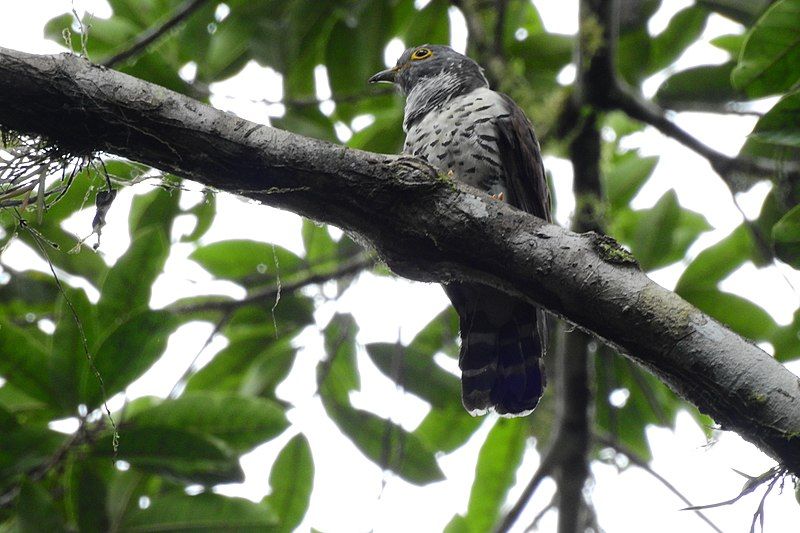
The Sulawesi cuckoo is a species of cuckoo that is unique to Sulawesi Island in Indonesia. Although it is often called the Sulawesi hawk-cuckoo, it is unrelated to other hawk-cuckoos.
This cuckoo species prefers to live in subtropical or tropical moist montane forests, which are forests in mountainous regions with a humid climate.
This environment is ideal for the Sulawesi cuckoo’s habitat because it provides ample food sources such as insects, fruits, and small animals. The humid climate also helps to keep the Sulawesi cuckoo safe from predators.
The Sulawesi cuckoo is an integral part of Sulawesi Island’s ecosystem, and its unique habitat gives it an essential place in the food chain.
| Kingdom | Animalia |
| Phylum | Chordata |
| Class | Aves |
| Order | Cuculiformes |
| Family | Cuculidae |
| Genus | Cuculus |
| Species | C. crassirostris |
13. Pink-necked Green Pigeon
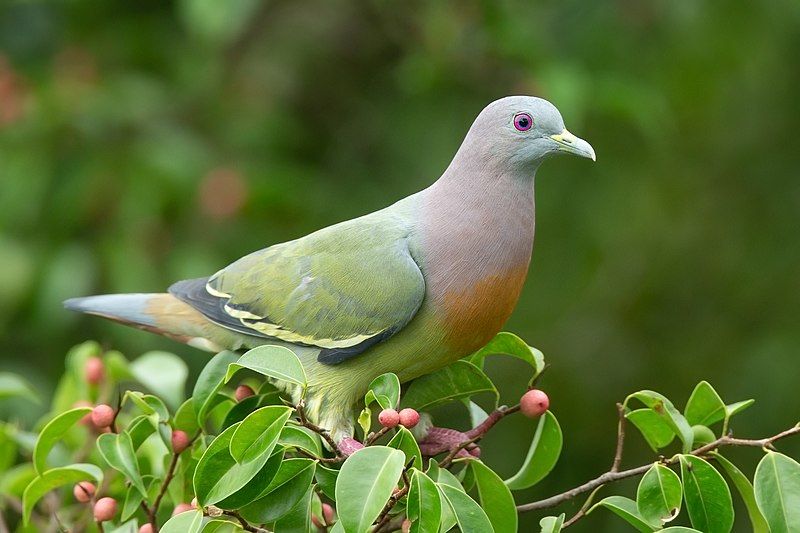
The pink-necked green pigeon is a species of bird belonging to the family Columbidae, which includes doves and pigeons. The species is found in many Southeast Asian countries, from Myanmar and Vietnam to the major islands of Indonesia and the Philippines.
It is a common bird species in this region and can be found in various habitats. The pink-necked green pigeon has distinctive plumage, with predominantly green feathers, an iridescent blue patch on its wings, and a pinkish neck.
Its head is greyish-brown, with a darker crest. Its eyes are orange-red. The bird typically grows to be around 33 cm in length. The pink-necked green pigeon feeds on various items such as fruits, buds, and seeds. It typically forages in pairs or small groups.
The species inhabits many habitats, such as forests, woodlands, cultivated areas, and mangrove swamps. The pink-necked green pigeon is not considered to be threatened and is listed as least Concern by the International Union for Conservation of Nature (IUCN).
However, its population is decreasing due to habitat destruction and hunting. Conservation efforts are needed to keep this species from further decline.
| Kingdom | Animalia |
| Phylum | Chordata |
| Class | Aves |
| Order | Columbiformes |
| Family | Columbidae |
| Genus | Treron |
| Species | T. vernans |
14. Green Imperial Pigeon
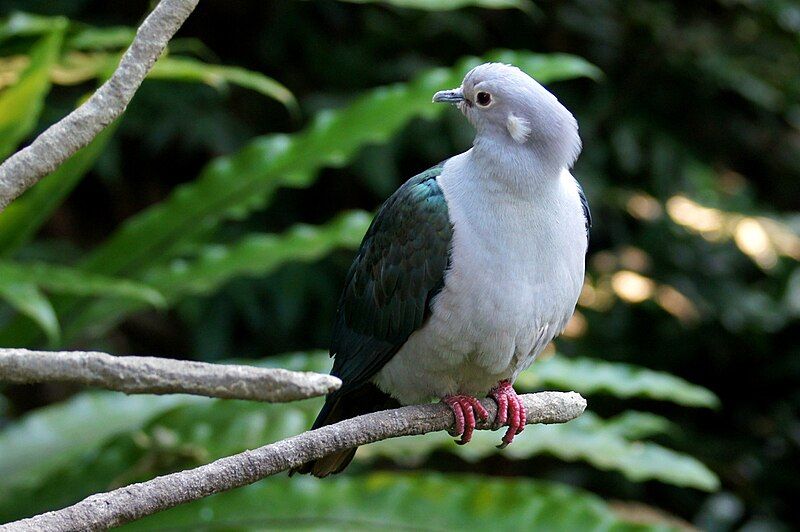
The green imperial pigeon is a sizeable forest-dwelling bird throughout South and Southeast Asia. It is native to Nepal, southern India, Sri Lanka, southern China, Indonesia, and the Philippines.
This pigeon species has a wide range, covering a large continent area. The green imperial pigeon is typically found in forests, typically inhabiting areas of dense vegetation, such as mangroves and thickets.
They are rarely found in open areas and are usually found in flocks of up to several hundred birds. They feed on various fruits and nuts and are considered an essential part of the ecosystem due to their role in dispersing seeds.
The green imperial pigeon is a large bird, growing up to around 50 cm long and weighing 600 grams. Its plumage is mainly green, with a white chest and a white line along the back. The head is blue-gray, and the bill is yellow.
The wings have a white patch near the tips, and the tail has a white tip. The green imperial pigeon is a highly social species, often seen in flocks of several hundred birds. They are relatively calm birds and are not usually aggressive towards humans.
They are also known as a noisy species, with a loud call that can be heard from a distance. In conclusion, the green imperial pigeon is an essential species in areas of South and Southeast Asia, where it is found in large numbers.
It is a large, social bird with colorful plumage and plays a vital role in seed dispersal in its habitat.
| Kingdom | Animalia |
| Phylum | Chordata |
| Class | Aves |
| Order | Columbiformes |
| Family | Columbidae |
| Genus | Ducula |
| Species | D. aenea |
15. Red Collared Dove
The Red Collared dove, also known as the Red Turtle Dove, is a species of small pigeon native to the tropical regions of Asia. The male of the species has a distinct physical appearance, with a blue-grey head and a red-brown body.
By contrast, the female of the species is much plainer, possessing a pale brown plumage that is very similar to that of the larger Eurasian Collared Dove. The Red Collared Dove is a resident breeding bird in Asia’s tropics and is widely distributed in the region.
This dove species is a small, plump bird with a short bill and tail. They are usually seen in small groups and feed on the ground on various grains, seeds, and insects. Red Collared Doves are generally quiet and have a soft, cooing call.
They also perform a courtship display called ‘billing,’ where the male and female rub their bills together.
This dove species is an integral part of the Asian ecosystem, providing food for larger birds of prey and other animals while helping keep the vegetation in check.
| Kingdom | Animalia |
| Phylum | Chordata |
| Class | Aves |
| Order | Columbiformes |
| Family | Columbidae |
| Genus | Streptopelia |
| Species | S. tranquebarica |
16. Zebra Dove
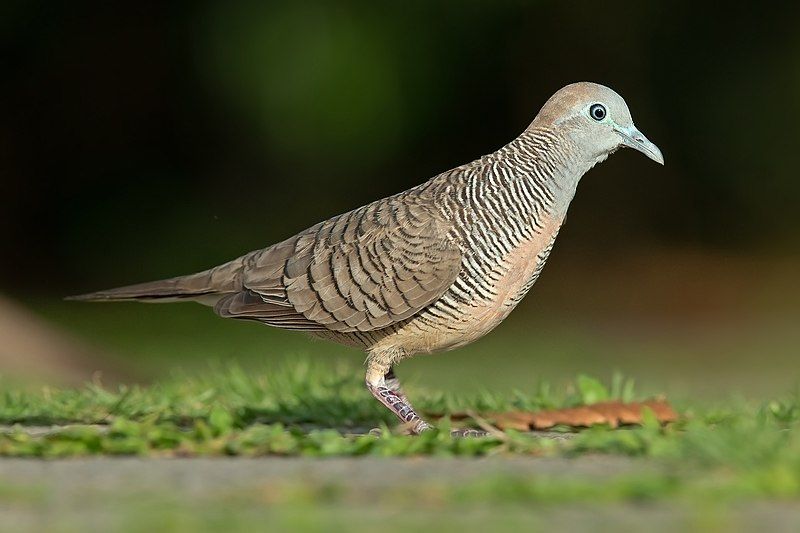
The Zebra Dove is a species of bird that belongs to the Columbidae family, commonly known as the Dove family. This species is native to Southeast Asia and is easily recognizable by its small size and long tail.
The Zebra Dove is predominately brownish-grey, with black and white barring patterns. Its wings are short and rounded, and its chest is usually a lighter shade of grey.
It has a distinctive barred pattern on its back and tail, which gives it its other name, the Barred Ground Dove or the Barred Dove. The Zebra Dove is a solitary bird, often seen perching on low shrubs or trees.
It feeds on various insects and seeds and may also feed on fallen fruit. The male and female appear similar, but the male has a brighter coloration and a longer tail. The Zebra Dove is a famous pet bird often kept in aviaries.
It is a hardy bird and is relatively easy to care for.
| Kingdom | Animalia |
| Phylum | Chordata |
| Class | Aves |
| Order | Columbiformes |
| Family | Columbidae |
| Genus | Geopelia |
| Species | G. striata |
17. Banggai Fruit Dove
The Banggai fruit dove, also known as the maroon-chinned fruit dove, is a bird species in the Columbidae family. It is only found on the Banggai Islands, located off the coast of Indonesia. This species prefers to inhabit subtropical or tropical moist lowland forests.
Unfortunately, this environment is threatened by habitat loss due to human activity, which puts the future of this species in danger.
Habitat loss can be caused by deforestation, land development, and pollution, all of which can destroy this species’ natural habitat. As a result, the Banggai fruit dove is listed as a threatened species, with their population decreasing.
This highlights the importance of conservation and protection of their habitat to ensure that this species will survive.
| Kingdom | Animalia |
| Phylum | Chordata |
| Class | Aves |
| Order | Columbiformes |
| Family | Columbidae |
| Genus | Ptilinopus |
| Species | P. subgularis |
18. Common Emerald Dove
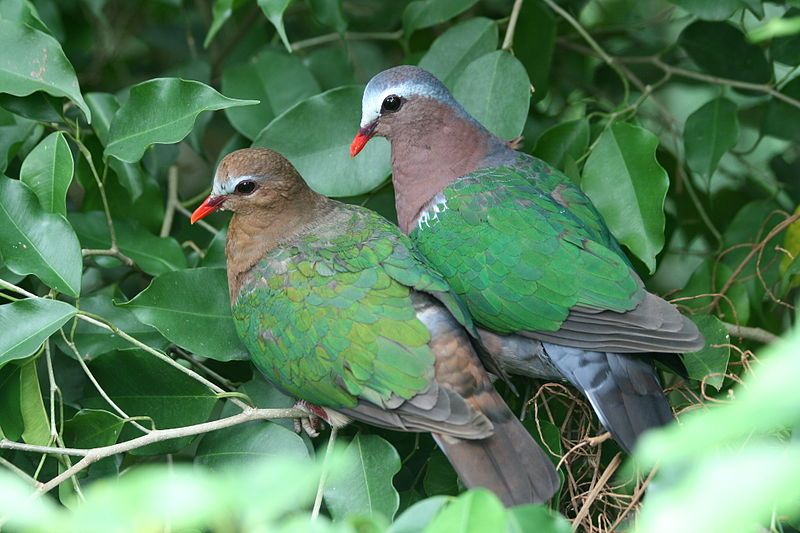
The emerald dove is a pigeon species in the Indian Subcontinent and Southeast Asia. The names of the common emerald dove, Asian emerald dove, grey-capped emerald dove, green dove, and green-winged pigeon are also known.
It is a widespread resident breeding bird, meaning it does not migrate and remains in the same general area year-round.
The emerald dove prefers to inhabit tropical and subtropical regions, making its home in various habitats, including forests, open woodlands, and agricultural areas. The dove is a medium-sized bird, usually around 30-35 cm long.
Its body is mostly grey and brown, with a distinctive greenish-black head and bright greenish-yellow wings. It is easily distinguishable from other doves due to its unique coloring.
The emerald dove also has a loud, repetitive call often heard in its habitat. The emerald dove is a relatively common bird and is not currently threatened. It is a widespread species in aviculture, and its striking coloration has made it a favorite amongst bird enthusiasts.
The dove is also famous in some cultures as a symbol of peace and prosperity. The emerald dove is an important species that plays a vital role in its native habitats.
| Kingdom | Animalia |
| Phylum | Chordata |
| Class | Aves |
| Order | Columbiformes |
| Family | Columbidae |
| Genus | Chalcophaps |
| Species | C. indica |
19. Spotted Dove
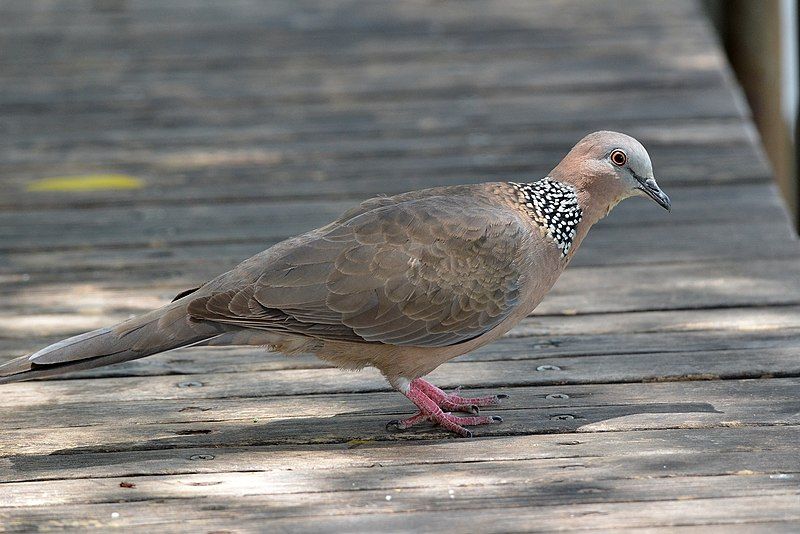
The spotted dove is a bird species native to the Indian subcontinent and Southeast Asia. It is a small pigeon with a long tail and is a common breeding bird in its native range.
It has been introduced to many parts of the world where feral populations have established themselves. The spotted dove is a famous bird for domestication, as it is relatively easy to take care of and has a pleasant song.
Its diet consists of seeds and grain, often seen in grassy areas foraging for food. The spotted dove has a grey or brown back and wings, a white face and neck, and black and white spotted markings on its chest.
It can reach 30 cm long and live for up to 7 years in the wild.
| Kingdom | Animalia |
| Phylum | Chordata |
| Class | Aves |
| Order | Columbiformes |
| Family | Columbidae |
| Genus | Spilopelia |
| Species | S. chinensis |
20. Black-backed Swamphen
The black-backed swamphen is a species of bird found in southeast Asia, Sulawesi, and Borneo. This species resembles the purple swamphen, but some distinguishing features set it apart.
The black-backed swamphen has a giant shield than the purple swamphen, and its upperparts are black. Additionally, the side of the head of the black-backed swamphen is blackish. This feature, along with its size, helps to differentiate it from other species of swamphens.
The black-backed swamphen is an interesting species that can be found living in the marshes and wetlands of the region. It is a species of conservation concern, and efforts are being made to protect it and its habitats.
| Kingdom | Animalia |
| Phylum | Chordata |
| Class | Aves |
| Order | Gruiformes |
| Family | Rallidae |
| Genus | Porphyrio |
| Species | P. indicus |
21. Isabelline Bush-hen
The Isabelline Bush-hen is a bird species found primarily in Sulawesi, Indonesia. It is the most giant bird of the Amaurornis genus, measuring up to 40 cm long.
The bird has a rufous and brown plumage derived from its characteristic color, hence the name Isabelline.
This bird species is also known as the Sulawesi waterhen or isabelline waterhen, and it is mainly found near bodies of water such as rivers, streams, and wetlands. It can also be found in secondary-growth forests, swamps, and mangroves.
The bird feeds mainly on aquatic invertebrates, such as snails, insects, larvae, and small fish. The Isabelline Bush-hen is an essential species in its habitat and is listed as Least Concern in the IUCN Red List.
The bird is threatened by habitat loss due to agricultural activities and deforestation. It is also threatened by hunting and trapping for the pet trade. Conservation efforts are being made to protect the species and its habitat.
| Kingdom | Animalia |
| Phylum | Chordata |
| Class | Aves |
| Order | Gruiformes |
| Family | Rallidae |
| Genus | Amaurornis |
| Species | A. isabellina |
22. Blue-faced Rail
The blue-faced rail is a species of bird that is part of the Rallidae family. It can only be found on the island of Sulawesi in Indonesia. It has a distinct blue facial marking that helps to distinguish it from other birds.
Its habitat includes subtropical or tropical moist lowland forests, tropical shrublands, and rivers. The blue-faced rail is a ground-dwelling bird that prefers to feed on insects, spiders, worms, and other invertebrates.
It is an essential part of Sulawesi’s ecosystem, for it helps to keep the insect populations in check. This species is also widespread among bird watchers, as it is relatively easy to spot in its natural habitat.
The blue-faced rail is listed as a vulnerable species on the IUCN Red List, and its population is in decline due to the loss of its natural habitat. Deforestation, agricultural activities, and urban development are the main culprits of its decline.
Conservation efforts are being taken to help protect the blue-faced rail and its habitat. These include implementing sustainable forest management, controlling agricultural activities, and safeguarding its existing habitat.
In addition, breeding programs have been set up in some areas to help increase the species’ population.
| Kingdom | Animalia |
| Phylum | Chordata |
| Class | Aves |
| Order | Gruiformes |
| Family | Rallidae |
| Genus | Gymnocrex |
| Species | G. rosenbergii |
23. Knobbed Hornbill
The knobbed hornbill, also known as Sulawesi wrinkled hornbill, is a bird native to Indonesia. It is a colorful bird with a distinct hornbill shape. It is sometimes placed in the genus Aceros, a group of birds related to hornbills with similar features.
The knobbed hornbill is the faunal symbol of South Sulawesi province, which is a province in Indonesia. This makes the knobbed hornbill a recognizable symbol of the area, and it also serves as an essential reminder of the natural beauty and biodiversity of the region.
The knobbed hornbill is an integral part of the local ecosystem, as it helps to disperse seeds and pollen, and it is also an important food source for many of the local predators.
The species is also a valuable source of income for local people, as some of them capture the birds for sale in the pet trade. Conservation efforts are essential to protect this species from threats like deforestation, hunting, and illegal trading.
| Kingdom | Animalia |
| Phylum | Chordata |
| Class | Aves |
| Order | Bucerotiformes |
| Family | Bucerotidae |
| Genus | Rhyticeros |
| Species | R. cassidix |
24. Sulawesi Blue Flycatcher
The Sulawesi blue flycatcher is a species of bird belonging to the family Muscicapidae. This species is endemic to Indonesia, meaning it is only found in this country and nowhere else.
Its natural habitats include subtropical or tropical moist lowland forests and subtropical or tropical moist montane forests. These are forests located in low-lying and mountainous regions, respectively.
The climate in these forests is usually humid, and the temperature is warm. These forests provide the Sulawesi blue flycatcher with the food, shelter, and nesting sites it needs to survive.
Additionally, these forests provide the bird with many resources to help it thrive, such as insects, berries, and other small animals.
This bird species is threatened due to habitat loss and fragmentation, as many of these forests are being destroyed for development.
We must protect these habitats to ensure the Sulawesi blue flycatcher can continue.
| Kingdom | Animalia |
| Phylum | Chordata |
| Class | Aves |
| Order | Passeriformes |
| Family | Muscicapidae |
| Genus | Cyornis |
| Species | C. omissus |
Conclusion
South Sulawesi is home to a diverse population of birds, with many species of both endemic and migratory birds in the region.
The abundance of birds in South Sulawesi is mainly due to the tropical climate and the presence of suitable habitats like wetlands and forests. Birdwatching is a popular activity in the area and a great way to experience the beauty of nature.
With the vast array of bird species in South Sulawesi, it is no wonder this region is a paradise for bird lovers.